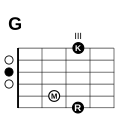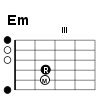Guitar/Campfire-Diploma Completion
This page is currently being translated from Germans Wikibooks into English. • Expect some errors and inconsistencies. •Images has to be repainted. The German fingering ZMRK = imrp (Z = Index, K = small Finger = pinKy •Some German words in pictures has to be translated. • Assisted the translator because he is not a native speaker. Feel free to correct mistakes and style. • The Wikitorians among you may help me with the peculiarities of English Wikibooks. (how do you handle things, what are your preferd templates...). •delete {:Guitar/under construction - in translation}if you think the translation is largely error-free and good enough.• Be patient. The translation of the finished German lesson (links in the navigation) will take time. |
Original page translated by Google
Completion of the campfire diploma
[edit | edit source]Done
[edit | edit source]The lessons for the campfire diploma have now been completed.
In the following pieces, we will repeat everything you have learned.
As with school, you don't have to get everything 100% right and without mistakes, and you don't have to memorize everything either. It's enough if you can accompany the songs to some extent so that you don't have to pause while singing because you're still looking for the next chord. You can get lost from time to time (but it should be limited), as long as you can always find your way back into the song.
- You have now mastered 6 chords
You know that you can simply ignore additions such as 7, sus, bass runs or similar for the time being. For example, instead of D7 you simply play a D
- You can also ignore letters under a slash = /.
- e.g. instead of C/B just play C
You know the general rules for fingering:
- index finger 1st fret
- middle finger 2nd fret
- Ring finger 3rd fret
- Little finger 4th fret
if there are several fingers in a fret, then Z. over M. over R. over K.
You know 5 strumming pattern
[edit | edit source]- and you can change chords within a bar (quick chord change)
You know two keys
- D major with the chords D, A and G major
- G major with the chords G, C and D major as well as Em and Am
- You have learned a few standard chord progression along the way
- G C D G (major cadence)
- G Em C D (50th cadence)
- G D Em C (pop cadence)
- G D G (4-5-1 final turn)
- Am D G (2-5-1 turn around)
- G C G (church ending)
- You know how to tune a guitar and what the name of the strings
- Every Amateur Does Get Better Eventually
- Every Amp Deserves Guitars / Basses Everyday
- You have acquired a small repertoire of songs.
- Believe it or not, you can already accompany hundreds of songs with this knowledge. A small selection of over 100 song examples can be found in the appendix.
The secondary dominant
[edit | edit source]We have learned that a key usually has 3 major chords. (tonic - subdominant - dominant). The relationship between the tension-building dominant and the resolving tonic is an important element. We are so familiar with it from hundreds of songs that we use this tension even where we don't expect it at first.
For example, we have the final sequence Am D G. Sometimes the Am can puff up into a major chord and pretend to be the dominant of the following D major chord. A D G. For a tiny moment, it sounds as if you are no longer in the key of G major, but in the key of D major. There, D is the tonic and A is the dominant. But this impression is only very brief, because the D major chord immediately resumes its function as the dominant and wants to be resolved to the tonic G major.
You also learn that no rule is so fixed that there are no exceptions to it. However, you need the rules in order to recognize the exceptions.
Imagine the A major chord, which doesn't usually occur in the G major scale, as a visit from close relatives. For example, when grandpa comes to visit, the father becomes the son (of the grandpa) again, and the son becomes the grandson. But the visit is only brief. As soon as he's gone again, the father is the father again and the son is the son.
When the Am becomes an A major, it can lead to the chord D major in the key of G major as an intermediate dominant. This is called a deviation.
Thanks to the short excursion into harmony, where we got to know the secondary dominant, we manage to find songs that contain all the chords we have learned so far. Along the way, we also learn how to change fingerings quickly in the practice examples. Gitarre: Liedervorschläge/ Abschlussstücke
Admittedly, the song "Ein Mann der sich Columbus nannt" or "Hoch auf dem gelben Wagen" is perhaps not quite as cool as "American Pie", but it also contains all the chords of the campfire diploma and you can practise the "quick fingering change" once again. If you can play the song without any problems, then you are definitely ready for the more contemporary pop songs that you will find in many songbooks. The campfire diploma has taught you all the techniques you need to be able to accompany songs you know the chords to on the guitar. Now it's up to you to put this knowledge into practice. So grab a songbook and browse through it for songs that you can already play.
You'll have to practise a little more with the final pieces, but it's worth it. If you can do them reasonably well, then you've really earned your campfire diploma. With the campfire diploma, you are no longer a beginner, but already a slightly advanced guitar player. Now it's time to consolidate and gradually expand your knowledge.
Weblinks
[edit | edit source]www.guitarplayerbox.com suggests almost 400 songs that you can play with these 6 chords.
What happens next
[edit | edit source]At the next opportunity, take a look at the chapters in the Appendices that you have not yet looked at. Try to find the lyrics and chords of the song suggestions in your songbooks and on the internet, which could not be printed in this volume due to copyright.
It continues with the Folkdiplom. You will learn another 6 chords and some other simple keys. Together with the 6 chords you have already learned, you will then be able to play the 12 most important basic chords. Most of the other chords can be derived from the 12 basic chords later on. Many folk songs, hits, folk songs and pop songs can be accompanied with these basic chords. You will gain an insight into important accompaniment techniques such as muffling beats, variations of beat patterns, bass runs, plucking patterns and much more. This will prepare you for more demanding accompaniment techniques.
have fun singing and playing guitar!

















